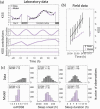Sleepiness is a signal to go to bed: data and model simulations
- PMID: 33991415
- PMCID: PMC8503825
- DOI: 10.1093/sleep/zsab123
Sleepiness is a signal to go to bed: data and model simulations
Abstract
Study objectives: Assess the validity of a subjective measure of sleepiness as an indicator of sleep drive by quantifying associations between intraindividual variation in evening sleepiness and bedtime, sleep duration, and next morning and subsequent evening sleepiness, in young adults.
Methods: Sleep timing and sleepiness were assessed in 19 students in late autumn and late spring on a total of 771 days. Karolinska Sleepiness Scales (KSS) were completed at half-hourly intervals at fixed clock times starting 4 h prior to participants' habitual bedtime, and in the morning. Associations between sleepiness and sleep timing were evaluated by mixed model and nonparametric approaches and simulated with a mathematical model for the homeostatic and circadian regulation of sleepiness.
Results: Intraindividual variation in evening sleepiness was very large, covering four or five points on the 9-point KSS scale, and was significantly associated with subsequent sleep timing. On average, a one point higher KSS value was followed by 20 min earlier bedtime, which led to 11 min longer sleep, which correlated with lower sleepiness next morning and the following evening. Associations between sleepiness and sleep timing were stronger in early compared to late sleepers. Model simulations indicated that the directions of associations between sleepiness and sleep timing are in accordance with their homeostatic and circadian regulation, even though much of the variance in evening sleepiness and details of its time course remain unexplained by the model.
Conclusion: Subjective sleepiness is a valid indicator of the drive for sleep which, if acted upon, can reduce insufficient sleep.
Keywords: circadian regulation; mathematical model simulations; sleep duration; sleep homeostasis; sleep timing; sleepiness.
© Sleep Research Society 2021. Published by Oxford University Press on behalf of the Sleep Research Society.
Figures







References
-
- He K, et al. Sleep-disordered breathing and excessive daytime sleepiness. Sleep Med Clin. 2017;12(3):369–382. - PubMed
-
- Akerstedt T, et al. Subjective sleepiness is a sensitive indicator of insufficient sleep and impaired waking function. J Sleep Res. 2014;23(3):240–252. - PubMed
-
- Wyatt JK, et al. Circadian temperature and melatonin rhythms, sleep, and neurobehavioral function in humans living on a 20-h day. Am J Physiol. 1999;277(4 Pt 2):R1152–R1163. - PubMed
-
- Agostini A, et al. An experimental study of adolescent sleep restriction during a simulated school week: changes in phase, sleep staging, performance and sleepiness. J Sleep Res. 2017;26(2):227–235. - PubMed
Publication types
MeSH terms
LinkOut - more resources
Full Text Sources
Other Literature Sources

